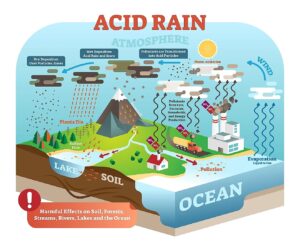Acid rain or acid deposition is defined as any form of precipitation with acidic components such as sulfuric acid or nitric acid that fall to the ground from the atmosphere in wet or dry forms. The forms of precipitation include rain, snow, fog, hail, or even dust that has acidic properties. Normal rain has a pH of about 5.6. It is slightly acidic because carbon dioxide (CO2) dissolves into atmospheric water forming weak carbonic acid. However, usually sulphuric- and nitric- acid rain has a pH between 4.2 and 4.4.

(picture courtesy: Acid rains – Bing images)
Steps of vicious cycle of acid rains:
(1) Emissions of Sulphur dioxide (SO2) and Nitric oxides (NOXs) are released into the atmosphere.
(2) The pollutants get transported to long distances due to the wind and air currents in atmosphere.
(3) These pollutant particles react with water, oxygen, and other chemicals to get transformed into Sulphuric and Nitric -acid particles.
(4) The acid particles then fall to the earth as wet and dry deposition (dust, rain, snow, etc.)
(5) This acidic precipitation causes harmful effects on atmosphere, soil, forests, streams, lakes, and oceans.
Major causes of acid rains:
• In electric power generators, open combustion of fossil fuels to generate electricity produces two thirds of SO2 and one fourth of NOXs in the atmosphere.
• Vehicles and heavy industrial equipment which are fuelled by gasoline and diesel produce harmful by-products like nitrogen dioxide, carbon dioxide, carbon monoxide, hydrocarbons, benzene, and formaldehyde.
• Manufacturing units of plastics, crude oil refineries, and open burning of plastic waste release pollutants that include sulphur oxides, nitrous oxides, methanol, ethylene oxide, and volatile organic compounds.
• A small portion of SO2 and NOX that cause acid rain is from natural sources such as volcanoes and forest wild fires, and human practices such as agricultural activities as well as construction and demolition of buildings.

picture courtesy: Acid rains – Bing images)
Forms of Acid Deposition
• Wet Deposition: This is the most commonly known form of acid rain. The sulphuric and nitric acids formed in the atmosphere fall to the ground mixed with rain, snow, fog, or hail.
• Dry Deposition: Acidic particles and gases can instantaneously deposit from the atmosphere in the absence of moisture as dry deposition onto land surfaces, water bodies, vegetation, buildings, etc.
Major effects of acid rains:
• Pollutants in air may react during atmospheric transport to form large sulphate and nitrate particles that are harmful to human health. Many scientific studies have shown a relationship between these particles and effects on heart and lung functions. Recently, increased heart and lung disease risk is causing heart attacks resulting in death and breathing difficulties for people with asthma respectively.
• Acid rain leaches aluminium and removes essential minerals and nutrients from the soil. This process is harmful to plants as well as animals.
• At high elevations, acidic fog and clouds strip nutrients from trees and foliage. Plants are able to absorb less sunlight than usual levels, which makes them weak and susceptible to freezing temperatures.
• When the accumulated acids on the land surface are washed off by the subsequent rains, this acidic water flows over and through the ground. This harms nitrogen and aluminium -sensitive plants and wildlife such as insects and fishes in fresh and ocean water ecosystems.
• Episodic acidification occurs when melting snow and heavy rain downpours occur in lakes and fresh water sources. This short duration of higher acidity (lower pH) than normal, results in a short-term stress on the ecosystem where a variety of organisms or species are injured or killed.
• Effects of dry acid rain deposition on materials and structures include corrosion and deterioration of stone-made artefacts, historical monuments, and metal-made statues, buildings, dams, and bridges.
• Additionally, objects made of plastic, glass, and paint are damaged on long-term exposure to acidic dust. This increases expenditure of damage repairs and maintenance.
• Moreover, NOX reacts with other pollutants to form ozone in lower layers of atmosphere which is hazardous to health of people and other living organisms.
• Furthermore, these acid particles and ozone become smog that makes the air hazy and difficult to see through long distances. This affects visibility that causes accidents during travel and discomfort to enjoy beautiful scenic views in tourist places.

(picture courtesy: effects of acid rain – Bing images)
Measuring Acid Rain:
• In addition to air quality, wet acid deposition intensity and frequency are measured at multiple monitoring sites across the world.
• Even dry acid deposition estimates for nitrogen and sulphur pollutants are recorded despite difficult and expensive procedures.
• The Long-Term Monitoring (LTM) Network monitors surface water chemistry at various sites to provide valuable information on aquatic ecosystem health.
• When acid deposition is washed into lakes and streams, it can cause acidification of water. The response of water bodies to changes in acid-causing emissions and acid deposition is an important subject to protect fresh and consumable water resources.
• Policymakers, research scientists, ecologists, and modelers rely on these data to propose and execute laws to maintain healthy atmosphere.
Steps to reduce acid rains:
• Globally, various programs are established by national governments and non-commercial organisations to control and prevent acid deposition.
• These acid rain prevention programs require reduction of SO2 and NOX emissions, the primary precursors of acid rain which are major by-products from the thermal power sector fuelled by fossil fuels.
• The installation of novel low-pollutant burner technologies to coal-fired utility boilers is the most cost-effective approach to reduce emissions.
• These programs have proven to be a highly effective way to achieve emission reductions, prevention of acid rains, decrease acidity of surface waters, meet environmental goals, and improve human health.
